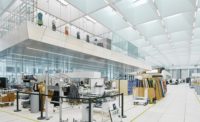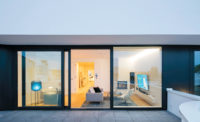To mark 50 years in business in 2010, the real-estate services company Société Privée de Gérance organized a worldwide design competition to reclad its 1970s-era Geneva, Switzerland, headquarters. Of the several dozen teams invited to submit design concepts for the new envelope, the winning entry by Pescara, Italy–based Giovanni Vaccarini Architetti (GVA) envisioned a birthday makeover with functional benefits. The scheme added three floors to the existing structure and replaced the strip-window facade with expansive triple-glazed units to maximize daylight penetration in the workspaces. A cloak of vertical fritted glass fins shields occupants against solar heat gain and glare.
Additional Content:
Jump to credits & specifications
The eight-story office building’s new envelope includes 100 tons of glass in total, with 2,900 glass fins in three sizes. The architects collaborated with Anières, Switzerland–based lighting designer Simon Simos on the solar analysis. Simos also suggested that they create a distinct nighttime presence for the headquarters by transforming the building into a literal haze of LED-emitted light after dusk. “A lighting project should always complement and reveal the architectural concept—sometimes in different ways from what the architect imagined,” says Simos, who determined that a lantern-like effect would underscore both the ethereality and weight of GVA’s design.
In order to achieve the desired blur of illumination, “our first concern was to create two slightly divergent 8-degree lighting beams to maximize reflection on the frit pattern while avoiding vertical light pollution,” Simos explains. The design team simultaneously calibrated the spacing between the fins to a minimum width of about 2 inches, so that they could insert uplights between them, positioned to graze the fritted fins without the fixtures’ appearing visible from the street, and to prevent light from leaking into the interior.
Rather than settle for off-the-shelf equipment, the design team worked with the engineers of a German architectural-lighting company to adapt an outdoor wall-washer that would meet its specifications. The resulting 290 custom luminaires—in 8- and 12-inch lengths, each with six or nine LED nodes, respectively—correspond to the dimensions and spacing between the fins. The manufacturer finished the waterproof devices in an anodized silver color to match the structural brackets that hold the glass fins, and it provided snap-fit clips for embedding the lights within the brackets, out of sight of passersby.
The modified luminaires are installed along three levels of the new facade, emitting a soft glow—at a color temperature of 3000 Kelvin—after dark. Simos devised multiple scenes that SPG can orchestrate via a custom building-automation platform. With several laptop keystrokes, the building can transition from a uniformly illuminated beacon to one with a surface on which blocks of light appear in a stairstep pattern.
Whatever the composition or sequence, Simos hopes the work will challenge perception, stir emotion, and even appeal to an onlooker’s desire for belonging. A successful “nocturnal signature,” he says, “not only influences the illuminated object but also its surroundings, defining the spirit of a particular place and its community.”
CreditsArchitect: Giovanni Vaccarini Architetti—Giovanni Vaccarini, principal
Architect of record: Fabio Fossati Architectes
Lighting designer: Simos Lighting Design—Simon Simos, principal
Engineering: Wintsch & Cie (structural); BCS (facade)
Consultant: Atelier R2D2 (lighting controls) |
SpecificationsExterior lighting Erco
Cladding Stahlbau Pichler (fin anchors) |











Post a comment to this article
Report Abusive Comment